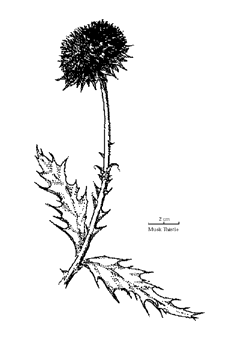Southeast Exotic Pest Plant Council Invasive Plant Manual
Common Name: Musk Thistle
Scientific Name: Carduus nutans L.
Musk thistle is an aggressive biennial plant with large, showy pink flowers on long multi-branched stems. Native to Europe and Asia, it was introduced into the U. S. more than ninety years ago and is declared a noxious weed in
many states. It is a member of the Asteraceae (Aster) family.
|
Height: Thistle stems are commonly 0.5-2.0 m (1.5-6 ft) tall, multi-branched and spiny.
Leaves: The dark green leaves are coarsely lobed, elliptic to lanceolate, with a smooth waxy surface, and a yellowish to white spine at the tip. Dimensions average 1.5-4.0 cm (0.5-1.5 in) wide, and 5-12 cm (2-5 in) long.
Flowers: Disk-shaped terminal flowers are 4-9 cm (1.5-3.5 in) wide, solitary, involucres and corollas are purple, outer bracts squarrose with spines. Flowers will droop to a 90-degree angle from the stem when large,
giving musk thistle its common nick-name, nodding thistle.
Seeds: Each plant may produce thousands of yellowish-brown or straw-colored seeds with attached plumose bristles.
Life History
Musk thistle is usually a biennial but may germinate and flower in a single year. Seedlings emerge in mid to late July and develop into a rosette of up to 1.2 m (4 ft) in diameter. Plants overwinter in the rosette stage until
they begin to bolt in mid-March. During the bolting stage plants form multi-branched stems to a height of 1.8 m (6 ft) The number of seed heads per plant is site dependent ranging from 241-561 on favorable sites to 1-18 heads
on less favorable sites. Flowers emerge in early May to August and may produce 1200 seeds per head and 120,000 seeds per plant. Seed dissemination occurs approximately one month after the flowers form and seeds may be wind
blown for miles. Seeds may remain viable in the soil for over ten years..
Origin and Distribution
A native of western Europe, musk thistle was introduced into the eastern UnitedStates in the early 1900s. It was discovered in Davidson County, Tennessee in 1942 and spread quickly throughout the state. Currently musk thistle is
present in forty states. It is widespread on railroad, highway, and power line rights-of-way, which become a large seed source for invasion of crop and pasture lands as well as open natural areas.
Similar Species
Musk thistle is similar to Canada thistle (Cirsium arvense [L.] Scop.) and bull thistle (Cirsium vulgare [Savi.]), both of which are also non-native. There is some evidence of hybridization occurring between musk
thistle and non-native plumeless thistle (Carduus acanthoides [L.]). Musk thistle is distinguished from other thistles by the usually large disk-shaped flowers.
Habitat
Establishment of an extensive population of musk thistle is dependent on the availability of light and water. It can grow from sea level to about 2500 m (8000 ft) and in neutral to acidic soil. It spreads rapidly in disturbed
areas and is sensitive to competition. Pasture-land is particularly vulnerable because the drainage is good, and livestock will avoid thistle due to its spiny leaves and stems. Although musk thistle is infrequently found in
dense forests, it can impact natural areas by colonizing areas of natural disturbance such as land slides or areas of frequent flooding. Meadows, prairies, grassy balds, and other open areas are susceptible to invasion. |


Photo by Norman E. Rees

Photo by Loke T. Kok

Photo by Loke T. Kok

Photo by Norman E. Rees
|
Management Recommendations
Mechanical Controls
Hand Pulling: This method is most effective on small populations. Hand pulling can be done throughout the year, but is most effective prior to the development of seeds. Flowers or seed heads should be bagged and disposed of to
prevent seed dispersal. Minimizing soil disturbance will help prevent germination of seeds already present in the soil.
Biological Controls
Two weevils have been introduced as a biological control for musk thistle: thistle head feeding weevil (Rhinocyllus conicus Froelich) and the rosette weevil (Trichosirocalus horridus Panzer). Although both weevils
have been successful, establishment may take several years, thistle populations must be relatively dense, and native thistles may be affected.
Herbicidal Controls
Foliar Spray Method: Apply a 2% solution of glyphosate or triclopyr and water plus a 0.5% non-ionic surfactant wetting all leaves and stems. A low pressure and coarse spray pattern will limit drift and damage to non-target
species. Treatments should be applied during the rosette stage or prior to flowering.
Bibliography
Beck, K. G.; Wilson, R. G.; Henson, M. A. The effects of selected herbicides on musk thistle (Carduus nutans) viable achene production. Weed Technology, 4:482-486; 1990.
Heidel, B. Carduus nutans: element stewardship abstract. The Nature Conservancy, Arlington, VA; 1985.
Hull, A. C., Jr.; Evans, J. O. Musk thistle (Carduus nutans) an undesirable range plant. Journal of Range Management 26(5):383-385; 1973.
Kok, K. T.; Surles, W. W. Successful biocontrol of musk thistle by an introduced weevil. Environmental Entomology 4(6):1025-1027; 1975.
Lacefield, G. D.; Gray, E. The life cycle of nodding thistle in Kentucky. Bowling Green, KY: Department of Agriculture, Western Kentucky University; 1970.
Lambdin, P. L.; Grant, J. F. Establishment of Rhinocyllus conicus(Coleoptera: Curculionidea) on musk thistle in Tennessee. Entomology News 103(5):193-198; 1992.
Monks, D. W.; Halcomb, M. A.; Ashburn, E. L. Survey and control of musk thistle (Carduus nutans) in Tennessee field nurseries. Weed Technology. 5:218-220; 1991.

